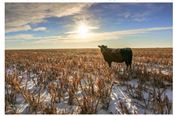Utilizing Sorghum Stalks For Grazing

Photo credit: Anne St. Blanc Lampe
BRENT BEAN
LUBBOCK, TEXAS
Grain sorghum stover left standingafter harvest provides ground cover during the winterand alsoserves as an inexpensive source of forage for cattle to graze. Approximately 50-60 percent of the plant dry matter of grain sorghum remains in the field after harvest. As a rule of thumb for estimating the amount of forage available, simply multiply the number of grain bushels harvested by 60. For example, a grain sorghum yield of 80 bushels per acre would leave approximately 4,800 pounds of stover in the field (80 bu/A x 60 = 4,800 lbs.).

The stover value of grain sorghum and corn are similar, although stalks of sorghum typically are taller than corn following harvest. This height difference allows for better utilization of the sorghum stalks and leaves, especially inregions where deep snow may accumulate for several days.
On average, sorghum stover contains 7.5 percent crude protein with total digestible nutrients (TDN) of 65 percent. The highest quality of stover occurs immediately following grain harvest and gradually decreasesbecause cattle consume the best forage first and the stover degrades over time. The energy and protein levels of sorghum stover are nutritious for cows in midgestation to late gestation, though supplements may be needed for heifers in late gestation. In a sorghum grazing study conducted by the University of Nebraska, steers consuming grain sorghum stover gained an average of 1.32 pounds per day over a 65-day grazing period.
Severe plant damage caused by sugarcane aphids can lower sorghum stover quality. However, a Texas A&M University study showed that even heavily damaged sorghum still had a TDN value of 60. According to Dr. Ted McCollum, Texas A&M beef cattle nutritionist, this TDN value is more than adequate for beef cows inlate gestation and early lactation. The sooty mold on the leaves that often accompanies sorghum heavily infested with sugarcane aphids occasionally may cause palatability issues, but it is not toxic to cattle.
Trials conducted in Nebraska showed no negative effects on corn or soybean yields following grazing of stalks – even in no-till or ridge-till systems. The top 0-3 inches of soil may have somewhat more compaction, leading to a slightly reduced water infiltration rate compared to ungrazed areas. To avoid compaction issues, growers should not allow cattle tograze stalks in the late spring when conditions may be muddy.
Growers may have some concerns over the loss of organic matter and nutrients consumed by cattle that would otherwise remain on the field. However, most of the nutrients are returned to the soil in the form of manure, and only between 10 and 12 percent of the organic matter potentially is lost. Normally, grazing removes less than 50 percent of the stover while the remaining crop residue is left on the field for erosion control.
Another concern of sorghum stover grazingis prussic acid. If grain sorghum is harvested prior to a killing freeze, or if glyphosate was not used to kill the plant, any new growth potentially can containhigh amounts of prussic acid. Cattle should be kept out of these fields until a hard freeze has killed the new growth. Growers should wait five to seven days after a killing freeze before allowing cattle into the sorghum field to providesufficient time for the prussic acid to dissipate. A more complete discussion on prussic acid can be found on the United Sorghum Checkoff website. ∆
BRENT BEAN: USCP Agronomist